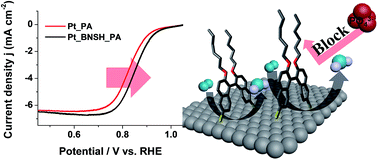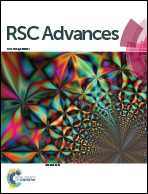Binaphthyl-based molecular barrier materials for phosphoric acid poisoning in high-temperature proton exchange membrane fuel cells†
Abstract
In this study, thiol-functionalized binaphthyl barrier molecules were designed and synthesized for eliminating phosphoric acid (PA)-poisoning on Pt catalysts in oxygen reduction reactions (ORRs). In high-temperature proton exchange membrane fuel cell, the ORR activity of Pt catalysts significantly decreases because of the PA poisoning. The binaphthyl thiol (BNSH) molecules with a tweezer-like structure can self-assemble on the Pt surface, thereby blocking the adsorption of PA, while permitting the approach of smaller oxygen molecules. After the treatment of Pt surfaces with BNSHs, the ORR activities were tested in the presence of PA, and the results were compared with respect to the molecular structures of BNSHs. Even in the presence of PA, the ORR activity of BNSH-treated Pt catalysts appeared to restore significantly up to the level of the pristine Pt without PA (kinetic current density at 0.8 V from 12 to 20.4 mA cm−2). This enhanced activity was attributed to the physical blocking of PA molecules on Pt surface and was affected by the molecular structures such as tweezer backbone, length of alkyl chains, and the type and number of functional groups.


 Please wait while we load your content...
Please wait while we load your content...